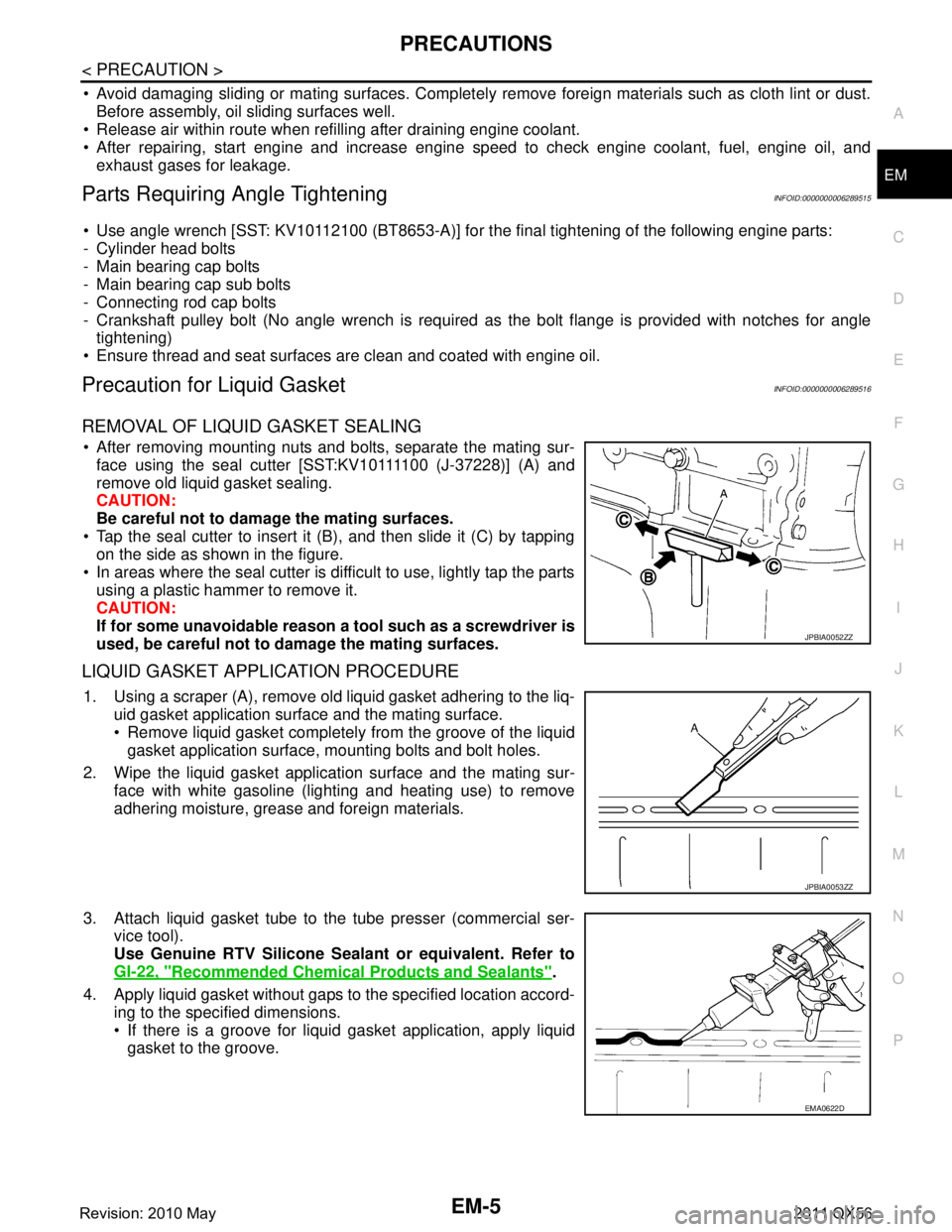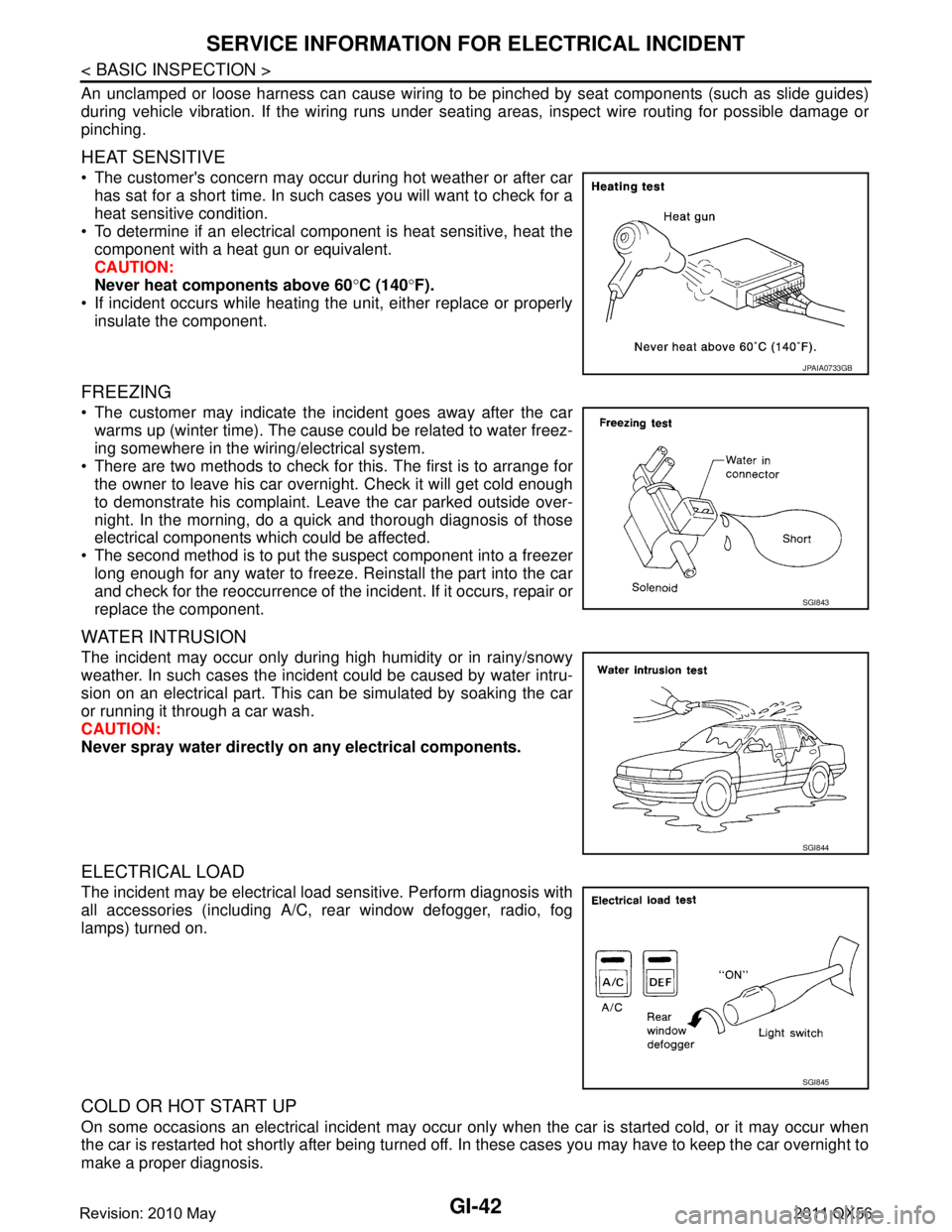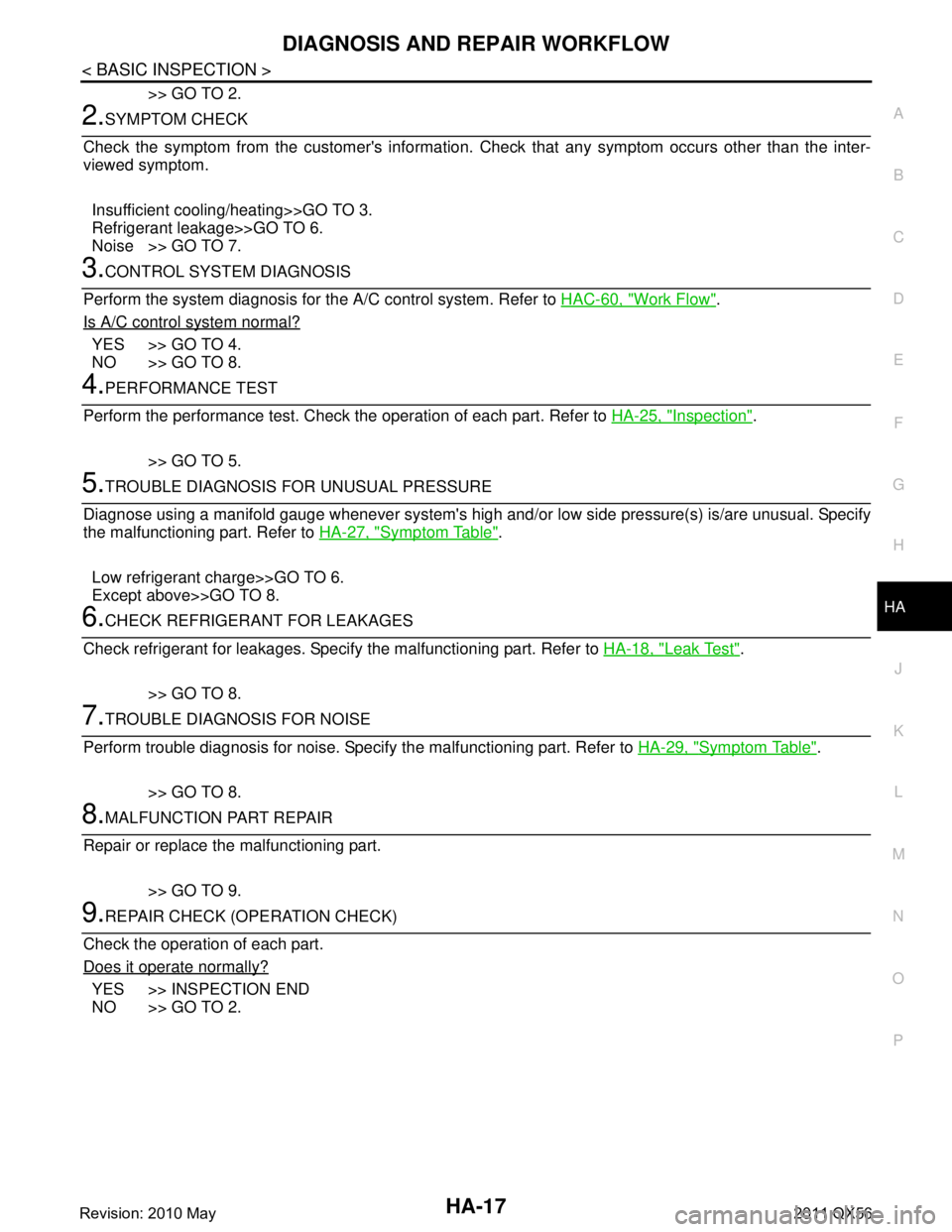2011 INFINITI QX56 heating
[x] Cancel search: heatingPage 2315 of 5598
![INFINITI QX56 2011 Factory Service Manual
P0300, P0301, P0302, P0303, P0304, P0305, P0306, P0307, P0308 MISFIRE
EC-291
< DTC/CIRCUIT DIAGNOSIS > [VK56VD]
C
D
E
F
G H
I
J
K L
M A
EC
NP
O
P0300, P0301, P0302, P0303, P0304,
P0305, P0306, P0307 INFINITI QX56 2011 Factory Service Manual
P0300, P0301, P0302, P0303, P0304, P0305, P0306, P0307, P0308 MISFIRE
EC-291
< DTC/CIRCUIT DIAGNOSIS > [VK56VD]
C
D
E
F
G H
I
J
K L
M A
EC
NP
O
P0300, P0301, P0302, P0303, P0304,
P0305, P0306, P0307](/manual-img/42/57033/w960_57033-2314.png)
P0300, P0301, P0302, P0303, P0304, P0305, P0306, P0307, P0308 MISFIRE
EC-291
< DTC/CIRCUIT DIAGNOSIS > [VK56VD]
C
D
E
F
G H
I
J
K L
M A
EC
NP
O
P0300, P0301, P0302, P0303, P0304,
P0305, P0306, P0307, P0308 MIS-
FIRE
DTC LogicINFOID:0000000006217840
DTC DETECTION LOGIC
When a misfire occurs, engine speed will fluctuate. If the engine speed fluctuates enough to cause the crank-
shaft position (CKP) sensor signal to vary, ECM can determine that a misfire is occurring.
The misfire detection logic consists of the following two conditions.
1. One Trip Detection Logic (Three Way Catalyst Damage) On the 1st trip that a misfire condition occurs that can damage the three way catalyst (TWC) due to over-
heating, the MIL will blink.
When a misfire condition occurs, the ECM monitors the CKP sensor signal every 200 engine revolutions
for a change.
When the misfire condition decreases to a level t hat will not damage the TWC, the MIL will turn off.
If another misfire condition occurs that can damage the TWC on a second trip, the MIL will blink.
When the misfire condition decreases to a level t hat will not damage the TWC, the MIL will remain on.
If another misfire condition occurs that can damage the TWC, the MIL will begin to blink again.
2. Two Trip Detection Logic (Exhaust quality deterioration) For misfire conditions that will not damage the TWC (but will affect vehicle emissions), the MIL will only
light when the misfire is detected on a second trip. Du ring this condition, the ECM monitors the CKP sen-
sor signal every 1,000 engine revolutions.
A misfire malfunction can be detected in any one cylinder or in multiple cylinders.
DTC CONFIRMATION PROCEDURE
1.PRECONDITIONING
1. Turn ignition switch OFF and wait at least 10 seconds.
2. Turn ignition switch ON.
3. Turn ignition switch OFF and wait at least 10 seconds.
Sensor Input signal to ECM ECM function
Crankshaft position sensor Engine speed On board diagnosis of misfire
DTC No. Trouble diagnosis name
(Trouble diagnosis content) DTC detecting condition Possible cause
P0300 MULTI CYL MISFIRE
(Multiple cylinder misfires detected) Multiple cylinders misfire.
Improper spark plug
Insufficient compression
Incorrect fuel pressure
The fuel injector circuit is open or shorted
Fuel injector
Intake air leakage
The ignition signal circuit is open or shorted
Lack of fuel
Signal plate
A/F sensor 1
Incorrect PCV hose connection
P0301
CYL 1 MISFIRE
(No.1 cylinder misfire detected)
No. 1 cylinder misfires.
P0302 CYL 2 MISFIRE
(No. 2 cylinder misfire detected) No. 2 cylinder misfires.
P0303 CYL 3 MISFIRE
(No. 3 cylinder misfire detected) No. 3 cylinder misfires.
P0304 CYL 4 MISFIRE
(No. 4 cylinder misfire detected)
No. 4 cylinder misfires.
P0305 CYL 5 MISFIRE
(No. 5 cylinder misfire detected) No. 5 cylinder misfires.
P0306 CYL 6 MISFIRE
(No. 6 cylinder misfire detected) No. 6 cylinder misfires.
P0307 CYL 7 MISFIRE
(No. 7 cylinder misfire detected)
No. 7 cylinder misfires.
P0308 CYL 8 MISFIRE
(No. 8 cylinder misfire detected) No. 8 cylinder misfires.
Revision: 2010 May2011 QX56
Page 2386 of 5598
![INFINITI QX56 2011 Factory Service Manual
EC-362
< DTC/CIRCUIT DIAGNOSIS >[VK56VD]
P050E COLD START CONTROL
P050E COLD START CONTROL
DescriptionINFOID:0000000006288336
ECM controls ignition timing and engine idle speed when engine is started INFINITI QX56 2011 Factory Service Manual
EC-362
< DTC/CIRCUIT DIAGNOSIS >[VK56VD]
P050E COLD START CONTROL
P050E COLD START CONTROL
DescriptionINFOID:0000000006288336
ECM controls ignition timing and engine idle speed when engine is started](/manual-img/42/57033/w960_57033-2385.png)
EC-362
< DTC/CIRCUIT DIAGNOSIS >[VK56VD]
P050E COLD START CONTROL
P050E COLD START CONTROL
DescriptionINFOID:0000000006288336
ECM controls ignition timing and engine idle speed when engine is started with pre-warming up condition.
This control promotes the activation of three way ca
talyst by heating the catalyst and reduces emissions.
DTC LogicINFOID:0000000006288337
DTC DETECTION LOGIC
NOTE:
If DTC P050E is displayed with other DTC, first perform the trouble diagnosis for other DTC.
DTC CONFIRMATION PROCEDURE
1.PRECONDITIONING
1. Turn ignition switch OFF and wait at least 10 seconds.
2. Turn ignition switch ON.
3. Turn ignition switch OFF and wait at least 10 seconds.
TESTING CONDITION:
Before performing the following procedure, confirm that battery voltage is 11 V or more at idle.
>> GO TO 2.
2.PERFORM DTC CONFIRMATION PROCEDURE-I
WITH CONSULT-III
1. Turn ignition switch OFF and wait at least 10 seconds.
2. Turn ignition switch ON.
3. Select “DATA MONITOR” mode with CONSULT-III.
4. Check the indication of “COOLAN TEMP/S”.
WITH GST
Follow the procedure “With CONSULT-III” above.
Is the value of
“COOLAN TEMP/S” between 5°C (41°F) and 36°C (97°F)?
YES >> GO TO 3.
NO-1 [If it is below 5 °C (41 °F)]>>Warm up the engine until the val ue of “COOLAN TEMP/S” reaches 5°C
(41 °F) or more. Retry from step 1.
NO-2 [If it is above 36 °C (97 °F)]>>Cool engine down to less than 36 °C (97 °F). Retry from step 1.
3.PERFORM DTC CONFIRMATION PROCEDURE-II
WITH CONSULT-III
1. Set the select lever in N range.
2. Start the engine and warm up in idle with the value of “COOLAN TEMP/S” between 5 °C (41 °F) and 40 °C
(104 °F) for more than 15 seconds.
3. Check 1st trip DTC.
WITH GST
Follow the procedure “With CONSULT-III” above.
Is 1st trip DTC detected?
YES >> Proceed to EC-362, "Diagnosis Procedure".
NO >> INSPECTION END
Diagnosis ProcedureINFOID:0000000006288338
1.PERFORM IDLE AIR VOLUME LEARNING
DTC No. Trouble diagnosis name DTC detecting condition Possible cause
P050E Cold start engine exhaust temper-
ature too low The temperature of the catalyst inlet does not
rise to the proper temperature when the engine
is started with pre-warming up condition. Lack of intake air volume
Fuel injection system
ECM
Revision: 2010 May2011 QX56
Page 2432 of 5598
![INFINITI QX56 2011 Factory Service Manual
EC-408
< DTC/CIRCUIT DIAGNOSIS >[VK56VD]
P1421 COLD START CONTROL
P1421 COLD START CONTROL
DescriptionINFOID:0000000006288263
ECM controls ignition timing and engine idle speed when engine is started INFINITI QX56 2011 Factory Service Manual
EC-408
< DTC/CIRCUIT DIAGNOSIS >[VK56VD]
P1421 COLD START CONTROL
P1421 COLD START CONTROL
DescriptionINFOID:0000000006288263
ECM controls ignition timing and engine idle speed when engine is started](/manual-img/42/57033/w960_57033-2431.png)
EC-408
< DTC/CIRCUIT DIAGNOSIS >[VK56VD]
P1421 COLD START CONTROL
P1421 COLD START CONTROL
DescriptionINFOID:0000000006288263
ECM controls ignition timing and engine idle speed when engine is started with prewarming up condition.
This control promotes the activation of three way ca
talyst by heating the catalyst and reduces emissions.
DTC LogicINFOID:0000000006288264
DTC DETECTION LOGIC
NOTE:
If DTC P1421 is displayed with other DTC, firs t perform the trouble diagnosis for other DTC.
DTC CONFIRMATION PROCEDURE
1.PRECONDITIONING
1. Turn ignition switch OFF and wait at least 10 seconds.
2. Turn ignition switch ON.
3. Turn ignition switch OFF and wait at least 10 seconds.
TESTING CONDITION:
Before performing the following procedure, confirm that battery voltage is more than 11 V at idle.
>> GO TO 2.
2.PERFORM DTC CONFIRMATION PROCEDURE
1. Turn ignition switch OFF and wait at least 10 seconds.
2. Turn ignition switch ON.
3. Select “DATA MONITOR” mode with CONSULT-III.
4. Check the indication of “COOLAN TEMP/S”. If it is between 7 °C (45 °F) and 36 °C (97 °F), go to the following steps.
If it is below 7 °C (45 °F), warm engine up to more than 7 °C (45 °F) and retry from step 1.
If it is above 36 °C (97 °F), cool engine down to less than 36 °C (97 °F) and retry from step 1.
5. Start engine and let it idle for 5 minutes.
6. Check 1st trip DTC.
Is 1st trip DTC detected?
YES >> Go to EC-408, "Diagnosis Procedure".
NO >> INSPECTION END
Diagnosis ProcedureINFOID:0000000006288265
1.PERFORM IDLE AIR VOLUME LEARNING
Perform EC-148, "
Work Procedure".
Is Idle Air Volume Learning carried out successfully?
YES >> GO TO 2.
NO >> Follow the instruction of Idle Air Volume Learning.
2.CHECK INTAKE SYSTEM
Check for the cause of intake air volume lacking. Refer to the following.
Crushed intake air passage
Intake air passage clogging
Is the inspection result normal?
YES >> GO TO 3.
DTC No. Trouble diagnosis name DTC detecting condition Possible cause
P1421 Cold start emission reduction
strategy monitoring ECM does not control ignition timing and engine
idle speed properly when engine is started with
prewarming up condition. Lack of intake air volume
Fuel injection system
ECM
Revision: 2010 May2011 QX56
Page 2434 of 5598
![INFINITI QX56 2011 Factory Service Manual
EC-410
< DTC/CIRCUIT DIAGNOSIS >[VK56VD]
P1423, P1424 COLD
START CONTROL
P1423, P1424 COLD START CONTROL
DescriptionINFOID:0000000006288266
ECM controls fuel injection timing and fuel injection quan INFINITI QX56 2011 Factory Service Manual
EC-410
< DTC/CIRCUIT DIAGNOSIS >[VK56VD]
P1423, P1424 COLD
START CONTROL
P1423, P1424 COLD START CONTROL
DescriptionINFOID:0000000006288266
ECM controls fuel injection timing and fuel injection quan](/manual-img/42/57033/w960_57033-2433.png)
EC-410
< DTC/CIRCUIT DIAGNOSIS >[VK56VD]
P1423, P1424 COLD
START CONTROL
P1423, P1424 COLD START CONTROL
DescriptionINFOID:0000000006288266
ECM controls fuel injection timing and fuel injection quantity when engine is started with the engine cold.
This control promotes the activation of three way ca talyst by heating the catalyst and reduces emissions.
DTC LogicINFOID:0000000006288267
DTC DETECTION LOGIC
NOTE:
If DTC P1423 or P1424 is displayed with other DTC, first perform the trouble diagnosis for other DTC.
DTC CONFIRMATION PROCEDURE
1.PRECONDITIONING
1. Turn ignition switch OFF and wait at least 10 seconds.
2. Turn ignition switch ON.
3. Turn ignition switch OFF and wait at least 10 seconds.
>> GO TO 2.
2.PERFORM DTC CONFIRMATION PROCEDURE
WITH CONSULT-III
1. Turn ignition switch OFF and wait at least 10 seconds.
2. Turn ignition switch ON.
3. Select “DATA MONITOR” mode with CONSULT-III.
4. Check that “COOLAN TEMP/S”.
- If it is between 5 °C (41 °F) and 40 °C (104 °F) go to the following steps.
- If it is below 5 °C (41 °F) warm engine up to more than 5 °C (41 °F) and retry from step 1.
- If it is above 40 °C (104 °F) cool engine down to less than 40 °C (104 °F) and retry from step 1.
5. Start engine and let it idle for 5 minutes.
6. Check 1st trip DTC.
WITH GST
Follow the procedure “With CONSULT-III” above.
Is 1st trip DTC detected?
YES >> Proceed to EC-410, "Diagnosis Procedure".
NO >> INSPECTION END
Diagnosis ProcedureINFOID:0000000006288268
1.INSPECTION START
1. Turn ignition switch ON.
2. Erase DTC.
3. Perform DTC confirmation procedure. Refer to EC-410, "
DTC Logic".
4. Check 1st trip DTC.
Is the 1st trip DTC P1423 or P1424 displayed again?
YES >> GO TO 2.
DTC No. Trouble diagnosis name
(Trouble diagnosis content) DTC detecting condition Possible cause
P1423 COLD START CONTROL
(Cold start emission reduction
strategy monitoring) ECM does not control fuel injection timing prop-
erly when engine is started with the engine cold.
ECM
P1424 COLD START CONTROL
(Cold start emission reduction
strategy monitoring) ECM does not control fuel injection quantity
properly when engine is started with with the en-
gine cold.
Revision: 2010 May2011 QX56
Page 2567 of 5598

PRECAUTIONSEM-5
< PRECAUTION >
C
DE
F
G H
I
J
K L
M A
EM
NP
O
Avoid damaging sliding or mating surfaces. Completely re
move foreign materials such as cloth lint or dust.
Before assembly, oil sliding surfaces well.
Release air within route when refilling after draining engine coolant.
After repairing, start engine and increase engine speed to check engine coolant, fuel, engine oil, and
exhaust gases for leakage.
Parts Requiring Angle TighteningINFOID:0000000006289515
Use angle wrench [SST: KV10112100 (BT8653-A)] for the final tightening of the following engine parts:
- Cylinder head bolts
- Main bearing cap bolts
- Main bearing cap sub bolts
- Connecting rod cap bolts
- Crankshaft pulley bolt (No angle wrench is required as the bolt flange is provided with notches for angletightening)
Ensure thread and seat surfaces are clean and coated with engine oil.
Precaution for Liquid GasketINFOID:0000000006289516
REMOVAL OF LIQUID GASKET SEALING
After removing mounting nuts and bolts, separate the mating sur- face using the seal cutter [SST:KV10111100 (J-37228)] (A) and
remove old liquid gasket sealing.
CAUTION:
Be careful not to damage the mating surfaces.
Tap the seal cutter to insert it (B), and then slide it (C) by tapping on the side as shown in the figure.
In areas where the seal cutter is difficult to use, lightly tap the parts using a plastic hammer to remove it.
CAUTION:
If for some unavoidable reason a tool such as a screwdriver is
used, be careful not to damage the mating surfaces.
LIQUID GASKET APPLICATION PROCEDURE
1. Using a scraper (A), remove old liquid gasket adhering to the liq- uid gasket application surface and the mating surface.
Remove liquid gasket completely from the groove of the liquidgasket application surface, mounting bolts and bolt holes.
2. Wipe the liquid gasket application surface and the mating sur- face with white gasoline (lighting and heating use) to remove
adhering moisture, grease and foreign materials.
3. Attach liquid gasket tube to the tube presser (commercial ser- vice tool).
Use Genuine RTV Silicone Seal ant or equivalent. Refer to
GI-22, "
Recommended Chemical Products and Sealants".
4. Apply liquid gasket without gaps to the specified location accord- ing to the specified dimensions.
If there is a groove for liquid gasket application, apply liquidgasket to the groove.
JPBIA0052ZZ
JPBIA0053ZZ
EMA0622D
Revision: 2010 May2011 QX56
Page 3006 of 5598

GI-42
< BASIC INSPECTION >
SERVICE INFORMATION FOR ELECTRICAL INCIDENT
An unclamped or loose harness can cause wiring to be pinched by seat components (such as slide guides)
during vehicle vibration. If the wiring runs under s eating areas, inspect wire routing for possible damage or
pinching.
HEAT SENSITIVE
The customer's concern may occur during hot weather or after car has sat for a short time. In such cases you will want to check for a
heat sensitive condition.
To determine if an electrical component is heat sensitive, heat the component with a heat gun or equivalent.
CAUTION:
Never heat components above 60 °C (140 °F).
If incident occurs while heating the unit, either replace or properly insulate the component.
FREEZING
The customer may indicate the incident goes away after the carwarms up (winter time). The cause could be related to water freez-
ing somewhere in the wiring/electrical system.
There are two methods to check for this. The first is to arrange for the owner to leave his car overnight. Check it will get cold enough
to demonstrate his complaint. Leave the car parked outside over-
night. In the morning, do a quick and thorough diagnosis of those
electrical components which could be affected.
The second method is to put the suspect component into a freezer long enough for any water to freeze. Reinstall the part into the car
and check for the reoccurrence of the incident. If it occurs, repair or
replace the component.
WATER INTRUSION
The incident may occur only during high humidity or in rainy/snowy
weather. In such cases the incident could be caused by water intru-
sion on an electrical part. This can be simulated by soaking the car
or running it through a car wash.
CAUTION:
Never spray water directly on any electrical components.
ELECTRICAL LOAD
The incident may be electrical load sensitive. Perform diagnosis with
all accessories (including A/C, rear window defogger, radio, fog
lamps) turned on.
COLD OR HOT START UP
On some occasions an electrical incident may occur only when the car is started cold, or it may occur when
the car is restarted hot shortly after being turned off. In these cases you may have to keep the car overnight to
make a proper diagnosis.
JPAIA0733GB
SGI843
SGI844
SGI845
Revision: 2010 May2011 QX56
Page 3073 of 5598

DIAGNOSIS AND REPAIR WORKFLOWHA-17
< BASIC INSPECTION >
C
DE
F
G H
J
K L
M A
B
HA
N
O P
>> GO TO 2.
2.SYMPTOM CHECK
Check the symptom from the customer's information. Check that any symptom occurs other than the inter-
viewed symptom.
Insufficient cooling/heating>>GO TO 3.
Refrigerant leakage>>GO TO 6.
Noise >> GO TO 7.
3.CONTROL SYSTEM DIAGNOSIS
Perform the system diagnosis for t he A/C control system. Refer to HAC-60, "
Work Flow".
Is A/C control system normal?
YES >> GO TO 4.
NO >> GO TO 8.
4.PERFORMANCE TEST
Perform the performance test. Check t he operation of each part. Refer to HA-25, "
Inspection".
>> GO TO 5.
5.TROUBLE DIAGNOSIS FOR UNUSUAL PRESSURE
Diagnose using a manifold gauge whenever system's high and/ or low side pressure(s) is/are unusual. Specify
the malfunctioning part. Refer to HA-27, "
Symptom Table".
Low refrigerant charge>>GO TO 6.
Except above>>GO TO 8.
6.CHECK REFRIGERANT FOR LEAKAGES
Check refrigerant for leakages. Specify the malfunctioning part. Refer to HA-18, "
Leak Test".
>> GO TO 8.
7.TROUBLE DIAGNOSIS FOR NOISE
Perform trouble diagnosis for noise. Specify the malfunctioning part. Refer to HA-29, "
Symptom Table".
>> GO TO 8.
8.MALFUNCTION PART REPAIR
Repair or replace the malfunctioning part.
>> GO TO 9.
9.REPAIR CHECK (OPERATION CHECK)
Check the operation of each part.
Does it operate normally?
YES >> INSPECTION END
NO >> GO TO 2.
Revision: 2010 May2011 QX56
Page 3110 of 5598

HAC-4
FRONT AUTOMATIC AIR CONDITIONING
SYSTEM .......................................................... .
133
Diagnosis Chart By Symptom .............................. ..133
REAR AUTOMATIC AIR CONDITIONING
SYSTEM .......................................................... .
135
Diagnosis Chart By Symptom .............................. ..135
ACCS (ADVANCE CLIMATE CONTROL
SYSTEM) .........................................................
137
Symptom Table ................................................... ..137
INSUFFICIENT COOLING ...............................138
FRONT AIR CONDITIONER .................................. ..138
FRONT AIR CONDITIONER : Description ............138
FRONT AIR CONDITIONER : Diagnosis Proce-
dure .......................................................................
138
REAR AIR CONDITIONER .................................... ..139
REAR AIR CONDITIONER : Description ...............139
REAR AIR CONDITIONER : Diagnosis Procedure
..
139
INSUFFICIENT HEATING .............................. .140
FRONT AIR CONDITIONER .................................. ..140
FRONT AIR CONDITIONER : Description ............140
FRONT AIR CONDITIONER : Diagnosis Proce-
dure .......................................................................
140
REAR AIR CONDITIONER .................................... ..140
REAR AIR CONDITIONER : Description ...............141
REAR AIR CONDITIONER : Diagnosis Procedure
..
141
COMPRESSOR DOSE DOT OPERATE ........ .142
Description ........................................................... ..142
Diagnosis Procedure .............................................142
REMOVAL AND INSTALLATION ..............144
FRONT A/C CONTROL .................................. .144
Removal and Installation ..................................... ..144
REAR A/C CONTROL .....................................145
Removal and Installation ..................................... ..145
A/C AUTO AMP. ..............................................146
Removal and Installation ..................................... ..146
AMBIENT SENSOR ..........................................147
Removal and Installation ...................................... .147
IN-VEHICLE SENSOR ......................................148
FRONT A/C UNIT ASSEMBLY ...............................148
FRONT A/C UNIT ASSEMBLY : Removal and In-
stallation ............................................................... .
148
REAR A/C UNIT ASSEMBLY .................................148
REAR A/C UNIT ASSEMBLY : Removal and In-
stallation ............................................................... .
148
SUNLOAD SENSOR ........................................149
Removal and Installation ...................................... .149
INTAKE SENSOR .............................................150
Exploded View ..................................................... .150
Removal and Installation .......................................150
EXHAUST GAS/OUTSIDE ODOR SENSOR ...151
Removal and Installation ...................................... .151
DOOR MOTOR .................................................152
Exploded View ..................................................... .152
MODE DOOR MOTOR ........................................... .153
MODE DOOR MOTOR : Removal and Installation .153
AIR MIX DOOR MOTOR ........................................ .153
AIR MIX DOOR MOTOR : Removal and Installa-
tion ....................................................................... .
153
INTAKE DOOR MOTOR ........................................ .153
INTAKE DOOR MOTOR : Removal and Installa-
tion ........................................................................
153
UPPER VENTILATOR DOOR MOTOR ..................154
UPPER VENTILATOR DOOR MOTOR : Removal
and Installation ..................................................... .
154
REAR MODE DOOR MOTOR ................................ .154
REAR MODE DOOR MOTOR : Removal and In-
stallation ................................................................
154
REAR AIR MIX DOOR MOTOR ............................. .154
REAR AIR MIX DOOR MOTOR : Removal and In-
stallation ................................................................
154
IONIZER ............................................................155
Exploded View ..................................................... .155
Removal and Installation .......................................155
Revision: 2010 May2011 QX56